Things to do in Hiroshima
Most of Hiroshima's must-see attractions revolve around the tragedy of the atomic bombing during World War II. Foremost among these is the Peace Memorial Park, which includes Ground Zero, the Cenotaph monument to the dead, the extremely moving Children's Peace Monument, dedicated to the children who died in the bombing, and the Hiroshima Peace Memorial Museum. These sites are naturally sombre and saddening but the emphasis on peace and forgiveness is hopeful and most people don't find the experience too depressing.
Other popular attractions in Hiroshima include the Shukkei-en Garden, the Hiroshima Museum of Art, the Mitaki Temple, Hiroshima Castle, and the Hiroshima City Museum of Contemporary Art. Hiroshima is surrounded by some lovely countryside and two of the best excursions are a trip to the breathtaking scenic area of Sandankyo Gorge and the beautiful little island of Miyajima.
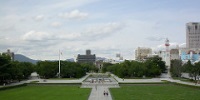
Peace Memorial Park
A complex of buildings and monuments was erected in the Peace Memorial Park, which lies around the epicentre of the 1945 atomic bomb explosion in Hiroshima. Central to the park is …
Peace Memorial Park
A complex of buildings and monuments was erected in the Peace Memorial Park, which lies around the epicentre of the 1945 atomic bomb explosion in Hiroshima. Central to the park is the only remaining building damaged in the blast, now known as the Atomic Bomb Dome.
The park also contains the Peace Memorial Museum, where visitors will find exhibits portraying the horrors of the bomb. Between the museum and the dome stands the Memorial Cenotaph. It has a stone chest that contains a list of all those killed in the explosion or who died from radiation poisoning.
The Cenotaph also houses the peace flame, which burns until nuclear war is no longer considered a threat to humanity. Other monuments include the Statue of the A-Bomb Children and the Atomic Bomb Memorial Mound, which holds the ashes of tens of thousands of unidentified victims.
Website www.pcf.city.hiroshima.jp/index_e2.html
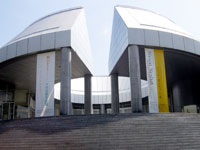
Hiroshima City Museum of Contemporary Art
Hiroshima boasts the first public art museum in Japan devoted exclusively to contemporary art. The museum sits high on a hill in Hijiyama Park, which is famed for its cherry blosso…
Hiroshima City Museum of Contemporary Art
Hiroshima boasts the first public art museum in Japan devoted exclusively to contemporary art. The museum sits high on a hill in Hijiyama Park, which is famed for its cherry blossoms and splendid city views. Established and up-and-coming Japanese artists are all represented, with the museum covering a range of different mediums and hosting regular temporary exhibitions.
For those not familiar with Japanese art, the museum provides information books written in English on the individual artists who are on display. There is an outdoor sculpture garden to enjoy in the lovely grounds and the Hiroshima Manga Library is also located here.
Website www.hiroshima-moca.jp
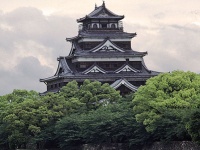
Hiroshima Castle
Hiroshima's original castle was totally destroyed in the atomic blast but has been reconstructed as a replica. When the castle was established by a feudal lord in 1589, Hiroshima d…
Hiroshima Castle
Hiroshima's original castle was totally destroyed in the atomic blast but has been reconstructed as a replica. When the castle was established by a feudal lord in 1589, Hiroshima didn't exist; the city that grew around the fortress took its name. At the time, the area was called Gokamura, meaning five small villages, and the lord ruled over a vast territory spanning nine provinces from the stronghold.
The castle now houses a museum detailing the region's history up until World War II and particularly the historic feudal system. The exhibits include some models of ancient Hiroshima and some traditional costumes to try on; visitors will find great lookout spots and tranquil grounds.
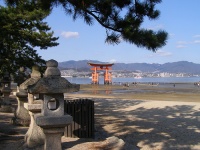
Miyajima
The romantic little island of Miyajima is scenically beautiful with steep wooded hills, and is famous for its 6th century Itsukushima Shrine featuring a massive red wooden torii (g…
Miyajima
The romantic little island of Miyajima is scenically beautiful with steep wooded hills, and is famous for its 6th century Itsukushima Shrine featuring a massive red wooden torii (gate). During high tide, the shrine stands in the ocean and is particularly picturesque when illuminated at night. The Daisho-in Temple is situated about halfway up the mountain with incredible views and a pathway strewn with hundreds of statues.
It's also worth exploring the temples and shrines near the summit of Mount Misen. The island offers great hiking opportunities, particularly in spring when the many cherry trees are in bloom, and in autumn, when the colours are at their most vibrant. Tame deer wander free and even bow if visitors give them a cookie, while monkeys chatter happily in the woods.
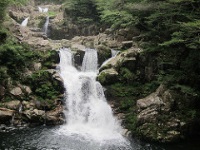
Sandankyo Gorge
Sandankyo Gorge is one of only five ravines in Japan that have been designated as National Scenic Beauty Spots, and the country takes great pride in the beautiful area, which is a …
Sandankyo Gorge
Sandankyo Gorge is one of only five ravines in Japan that have been designated as National Scenic Beauty Spots, and the country takes great pride in the beautiful area, which is a favourite with hikers. The erosion of a limestone plateau created this beautiful deep, 11-mile-long (18km) gorge of primeval forest, waterfalls and unusual rock formations. The Onbashi Bridge formation is the largest natural bridge in Japan.
One of the most popular walking trails begins at the front gate with the lovely Kurafuchi pool, known for its emerald green water, as the turning point. On this route visitors will also see the Shimai waterfall and Ishidoi rapids. It's closed in winter because snow makes the ravine impassable and dangerous.



